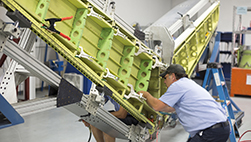by Charlotte Adams
 Composites are popular in business aviation aircraft. Equally important for aftermarket care is the fact that these materials are frequently found, not just in essentially cosmetic parts, but also in critical components such as flight control surfaces, tail assemblies, and even fuselages.
Composites are popular in business aviation aircraft. Equally important for aftermarket care is the fact that these materials are frequently found, not just in essentially cosmetic parts, but also in critical components such as flight control surfaces, tail assemblies, and even fuselages.
Composite materials are attractive to manufacturers and operators because of their light weight, corrosion resistance, and durability, compared with aluminium. Carbon composites boast high strength-to-weight and stiffness-to-weight ratios. And composites can be moulded into complex aerodynamic shapes. Their lighter weight, resilience, and durability mean fuel savings for operators and may translate to longer maintenance intervals and lower long-term ownership costs. Even large airframe parts such as the fuselage of the recently introduced HondaJet is composite.
Although older materials like Kevlar are susceptible to moisture ingress, modern composites are more resistant to moisture, corrosion effects, and cracking. “Pound for pound they outlast metallic structures,” said Raj Narayanan, accountable manager for Aerospace Quality Research and Development (AQRD), a company which combines both FAA designated engineering representative (DER) authority and repair station capability. If you know how to inspect and treat composite structures, they should provide lower life cycle maintenance costs, he explained.
Nevertheless these materials are susceptible to damage, including impact damage, ply delamination, punctures, erosion from wind and sand, water damage, and contamination from engine oil or hydraulic fluid. Problems can include damage to the skin or to the core or to both the skin and the core of a sandwich structure.
The tradeoff with composites comes on the aftermarket side. Composites can be two to three times as difficult to repair as their aluminium counterparts, said Narayanan. Composite repairs are very process-specific, he explained, and the process can differ from part to part, airplane to airplane. This multiplicity of unique processes is an additional challenge in designing repairs for these materials.
Furthermore, airplane original equipment manufacturers (OEMs) are not supporting legacy aircraft as much as they used to do, According to Narayanan “their business model puts a premium on replacement rather than repair. Under its DER authority AQRD ‘develops repairs where none exist’.” (See sidebar on Reverse-Engineered Solutions.)